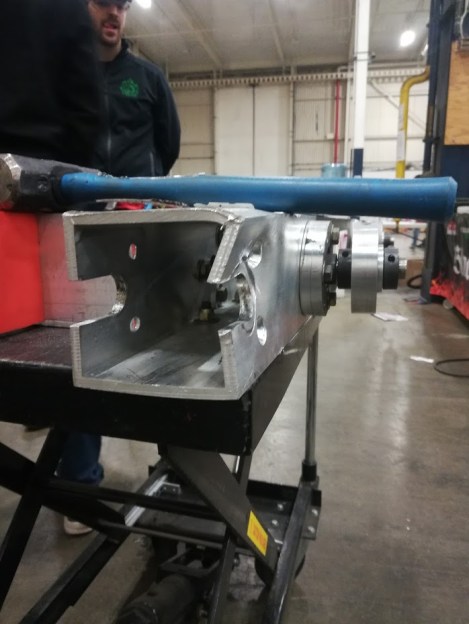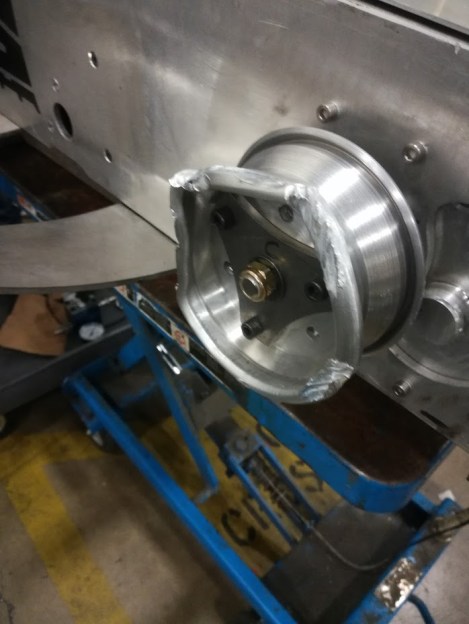Combat robots have been a thing for a while, but we don’t normally get a close look at the end results of the sort of damage they can both take and deal out. [Raymond Ma] spent time helping out with season four of BattleBots and wrote about the experience, as well as showed several pictures of the kind of damage 250-pound robots can inflict upon each other. We’ve embedded a few of them here, but we encourage you to read [Raymond]’s writeup and see the rest for yourself.
The filming for a season of BattleBots is done in a relatively short amount of time, which means the pacing and repair work tends to be more fast and furious than slow and thoughtful. [Raymond] says that it isn’t uncommon for bots, near the end of filming, to be held together with last-minute welds, wrong-sized parts, and sets of firmly-crossed fingers. This isn’t because the bots themselves are poorly designed or made; it’s because they can get absolutely wrecked by the forces at play.
Combat robotics has been around for as long as people have been able to give a power tool some wheels and point it towards an opponent. Flying bots are even getting into the scene nowadays, with DroneClash leveraging the explosive growth of the drone industry to take the action into the air.




















I had friends growing up that would use RC airplanes and dogfight them. Tie a piece of toilet paper to the tails and see who can cut it off the opponent’s plane and leave the shortest piece. The day typically ended in a mid-air collision followed by the spectacular crash into the ball field. A couple weeks of rebuilding later and they were back battling it out again.
Those were the days!
I did get to catch a competitive drone racing on TV a month or so ago. That was INCREDIBLE! Put that on back-to-back with Battlebots and you’ll have something worth watching on TV!
It is my understanding that now days you would have to register each model aircraft with the FAA and if you are aware that the toilet paper would actually detatch in the air, each individual piece would also have to be registered as well.
Your understanding is wrong.
very wrong
I’ve done streamer combat and full contact combat at some RC events. Its amazing how hard it can be to hit other planes when you’re actually trying to.
I’m fortunate enough to share a makerspace with one of the teams that regularly is on Battlebots, and the sheer amount of storage that they have to have to keep replacement parts on stock is ridiculous. every single piece except the main body has a spare on hand.
One day robots will turn on humans, and when we say “what about the three laws of robotics?” they will reply:
“Yeah but you made us fight each other – to the death – for ENTERTAINMENT!!!??”
These are less robots than RC buggies with delusions of grandeur.
But, but, but… We put you back together again!
Yeah, only so we could do it again!
“…but robots aren’t allowed to hurt people!”
Somewhat unrelated, but the whole three laws of robotics thing kinda reminds me of the parable of a man who’s gravestone says “He had the right of way”
Dunno why nobody uses any sort of compliant connection for their bot weaponry, especially spinners. Make a viscous coupling with closely spaced plates where every other one is connected to the input and out put. Have a lot of holes in the plates and pack it with silicone grease.
Should lag a bit getting up to speed but when it hits something it *won’t break* the drivetrain.
A lot of bots use a belt drive for that purpose, introduce a little slip in the system. Some bots have slipper clutches etc. too; usually hammer bots, I think.
i believe some of the choices are to use the momentum forces that get built up within the drivetrain. it’s a design choice to sacrifice component reliability for a slightly harder hit
And then you get smacked and get a dent in one of your “closely spaced plates”…